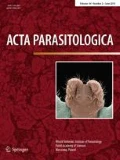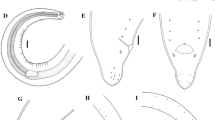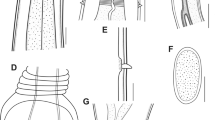Abstract
Introduction
Porrocaecum semiteres (Zeder, 1800) (Ascaridida: Ascaridoidea) occurs frequently in various birds in Europe. However, the knowledge of the morphology of this species remains insufficient.
Methods
Light and scanning electron microscopy were used to study the detailed morphology of adults of P. semiteres based on newly collected specimens from Turdus philomelos in the Czech Republic.
Results
Some previously unreported morphological features were revealed, including the presence of a medio-apical notch, 70–80 small conical denticles and one pair of submedial pores on each lip, the absence of caudal alae, the presence of four pairs of postcloacal papillae, and a single, medio-ventral precloacal papilla.


Similar content being viewed by others
References
Baruš V., Sitko J., Tenora F. 1978. Nematoda and Pentastomida parasiting gulls (Aves: Laridae) in Bohemia and Moravia. Acta Scientiarum Naturalium Brno, 26, 169–189.
Cram E. 1927. Bird parasites of nematode suborders Strongylata, Ascaridata and Spirurata. Bulletin of the United States National Museum, 140, 135–146.
Digiani M.C., Sutton C.A. 2001. New reports and a redescription of Porrocaecum heteropterum (Diesing, 1851) (Ascarididae), a rare nematode parasitic in South American threskiornithid birds. Systematic Parasitology, 49, 1–6. https://doi.org/10.1023/a:1010730611828.
Fagerholm H.-P., Overstreet R.M. 2009. Ascaridoid nematodes: Contracaecum, Porrocaecum, and Baylisascaris. In: Atkinson, C. T., Thomas, N. J., & Hunter, D. B. (Eds) Parasitic diseases of wild birds. Oxford: Wiley-Blackwell, pp. 413–433.
Frantová D. 2002a. On the morphology and surface ultrastructure of some parasitic nematodes (Nematoda) of birds (Aves). Acta Societatis Zoologicae Bohemicae, 66, 85–97.
Frantová D. 2002b. Some parasitic nematodes (Nematoda) of birds (Aves) in the Czech Republic. Acta Societatis Zoologicae Bohemicae, 66, 13–28.
Hartwich G. 1975. Parasitische Rundwürmer von Wirbeltieren. I. Rhabditida und Ascaridida. In: Die Tierwelt Deutschlands, Teil 62. Jena. p. 256.
Hartwich G. 1979. Ascariden (Nematoda, Ascaridoidea) aus Vögeln von Ungarn. Parasitologia Hungarica, 12, 79–85.
Jogis V. 1967. [Life-cycle of Porrocaecum semiteres (Zeder, 1800) (Nematoda: Ascaridata).] Parazitologiya, 1, 213–218 (In Russian).
Lewis E.A. 1926. Helminths of wild birds found in the Aberystwyth area. Journal of Helminthology, 4, 7–12. https://doi.org/10.1017/s0022149x00002108.
Li L., Guo Y.-N., Zhang L.-P. 2015. Porrocaecum parvum n. sp. and P. reticulatum (Linstow, 1899) (Nematoda: Ascaridoidea) from birds in China. Systematic Parasitology, 92, 141–149. https://doi.org/10.1007/s11230-015-9593-9.
Osche G. 1959. Über Zwischenwirte, Fehlwirte und die Morphogenese der Lippenregion bei Porrocaecum- und Contracaecum-Arten (Ascaridoidea, Nematoda). Zeitschrift für Parasitenkunde, 19, 458–484. https://doi.org/10.1007/bf00259736.
Moravec F. 1971. A new natural intermediate host of the nematode Porrocaecum semiteres (Zeder, 1800). Folia Parasitologica, 18, 26.
Mozgovoi A.A. 1953. [Ascaridata of animals and man and the diseases caused by them.] In: Skrjabin, K. I. (Ed.) Osnovy Nematologii, Volume 2. Moscow: Izdatel’stvo Akademii Nauk SSSR, 617 pp (In Russian).
Wong P.L., Anderson R.C. 1993. New and described species of nematodes from shorebirds (Charadriiformes) collected in spring in Iceland. Systematic Parasitology, 25, 187–202. https://doi.org/10.1007/bf00007008.
Acknowledgements
The authors wish to thank František Marec (Institute of Entomology, Biology Centre of the Czech Academy of Sciences, České Budějovice, Czech Republic) for providing the freshly dead host and František Moravec (Institute of Parasitology, Biology Centre of the Czech Academy of Sciences, České Budějovice, Czech Republic) for providing useful literature. We are also grateful to Dr. Hui-Xia Chen (Hebei Normal University, Shijiazhuang, China) for help with the illustrations. This study was supported by the National Natural Science Foundation of China (NSFC-31572231), Natural Science Foundation of Hebei Province (NSFH-C2016205088), the Youth Top Talent Support Program of Hebei Province for Liang Li, and the Institute of Parasitology (RVO: 60077344).
Author information
Authors and Affiliations
Corresponding author
Ethics declarations
Conflict of interest
The authors declare that they have no conflict of interest.
Additional information
Publisher's Note
Springer Nature remains neutral with regard to jurisdictional claims in published maps and institutional affiliations.
Rights and permissions
About this article
Cite this article
Li, L., Scholz, T. Redescription of Porrocaecum semiteres (Zeder, 1800) (Nematoda: Ascaridida) from the Song Thrush Turdus philomelos (Passeriformes: Turdidae). Acta Parasit. 64, 1–6 (2019). https://doi.org/10.2478/s11686-018-00001-z
Received:
Revised:
Published:
Issue Date:
DOI: https://doi.org/10.2478/s11686-018-00001-z




